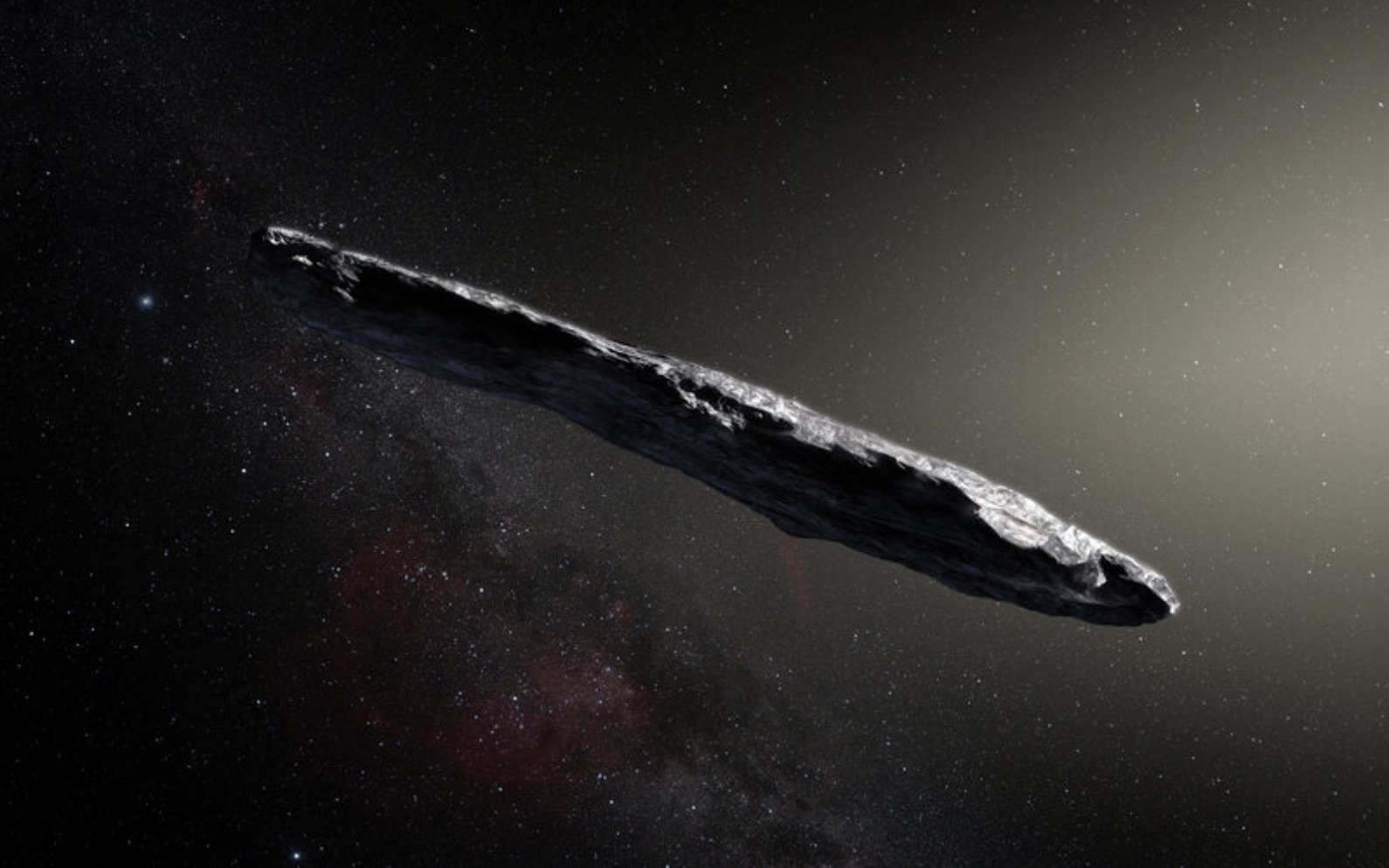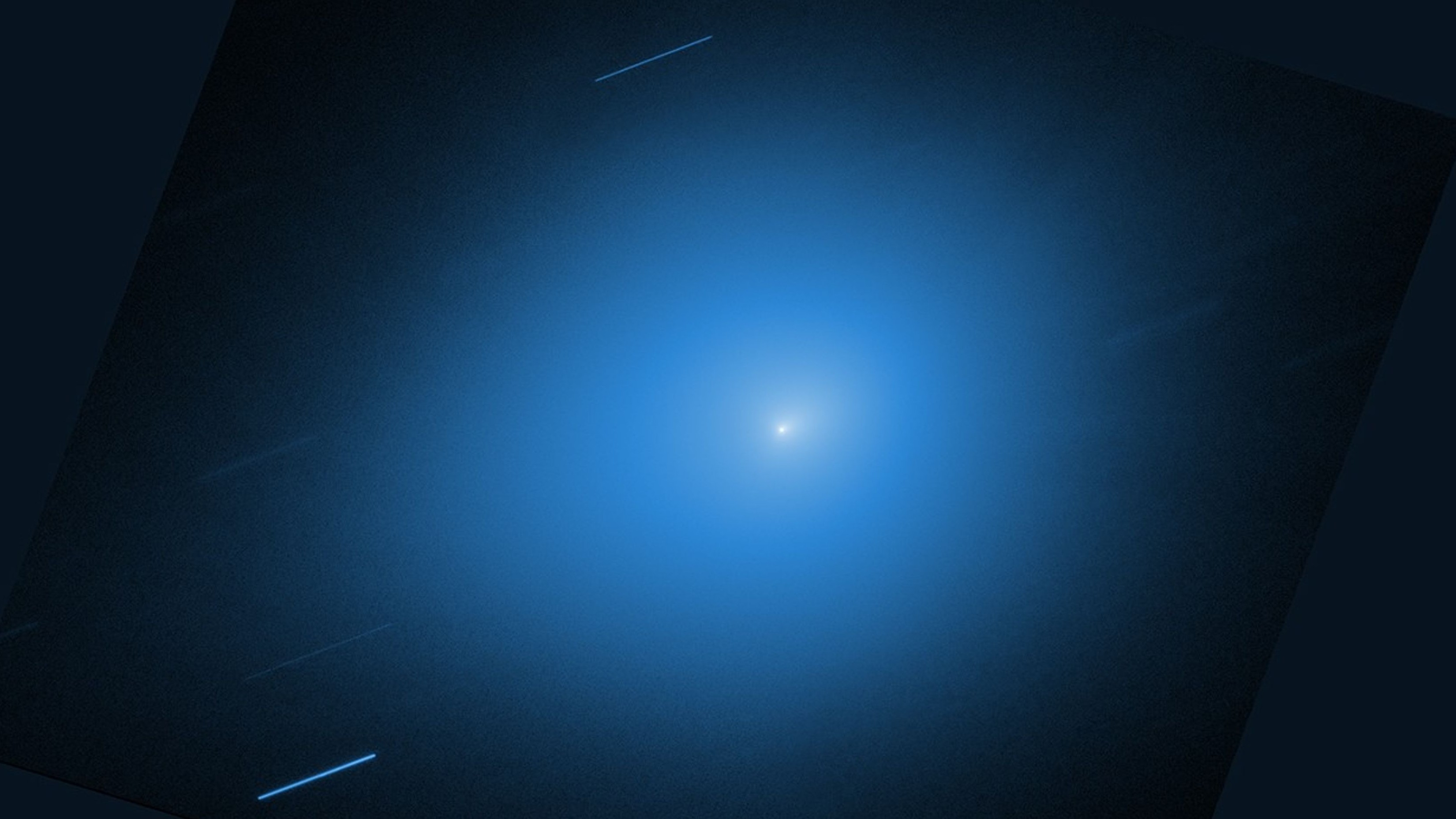Interstellar visitor 'Oumuamua came from an 'alien Pluto,' new study suggests
A new theory takes a swing at the bizarre 2017 mystery object.

Back in 2017, a point of strange light flashed through the solar system. Three years later, a team of scientists claims to have figured out what it was.
That light was the first interstellar visitor ever detected in solar space. Scientists put forth several eye-popping theories from that brief glance: Maybe it was a piece of discarded alien technology. Maybe it was a cosmic dust bunny, made of incredibly fragile frozen hydrogen. Now, another team of researchers claims to have cracked the problem of 'Oumuamua: It was a nitrogen iceberg, they argue, snapped off from a frigid alien Pluto.
Scientists reach for exotic theories to explain 'Oumuamua because it didn't look like any comet anyone had ever seen before. Not only did it hail from interstellar space, but it also flashed like a lighthouse beacon. No telescope snapped a decent enough image of it to reveal its shape, but that regular pattern of shifting light suggests that the object was spinning and waeither wide and flat like a frisbee or very long and thin like a cigar.
Related: The 12 strangest objects in the universe
Even stranger: It accelerated as it passed the sun, as if it were a weak rocket engine pumping out some sort of propellant. Comets do this too, but their propellant — water vapor — is visible to telescopes. Whatever was pushing 'Oumuamua along wasn't.
Both previous popular theories for 'Oumuamua's origin were designed to explain both features of the distant, flashing dot.
The alien technology theory, advanced by Harvard astrophysicist Avi Loeb, suggests that the object was a light sail — a wide, ultrathin and ultralight disk manufactured by some alien civilization that accelerated due to the pressure of solar radiation. The theory fits the data, but other scientists argued that jumping to an alien explanation isn't necessary. 'Oumuamua is weird, yes, but mainly because astronomers just didn't get a very good look at it, researchers wrote in 2019 in the journal Nature.
Get the world’s most fascinating discoveries delivered straight to your inbox.
The cosmic dust bunny theory proposes that the object was more or less a cigar-shaped, puffy cloud of solid hydrogen and interstellar dust. Evaporating hydrogen would accelerate such an object passing near the sun just as water vapor coming off of a conventional comet. The problem with this theory is it's not clear whether there's any place in the universe cold enough to form a hydrogen iceberg, or whether such an iceberg would survive long enough to reach the solar system.
Hydrogen freezes just a few degrees above absolute zero — something that's never been seen happening anywhere in space — and even the distant light of faraway stars and the faint glow of the cosmic microwave background would cook a block of free-floating hydrogen iceberg to death if it drifted through the universe for too long.
Now, a new set of research discounts both theories in favor of a new one: the nitrogen iceberg hypothesis.
In a pair of papers published March 16 in the Journal of Geophysical Research: Planets, two Arizona State University researchers argue that a nitrogen iceberg fits the data at least as well as a hydrogen iceberg: Such an iceberg could have become a wide disk as its surface slowly evaporated during its travels through the galaxy, just like a bar of soap flattens over the course of many showers. And, like hydrogen, evaporating nitrogen wouldn't be visible to telescopes.
Even better: Astronomers have actually seen nitrogen ice form in space. Pluto's surface is studded with shiny chunks of it, which were seen when NASA's New Horizons probe flew by the dwarf planet in 2015.
Over time, the researchers wrote, collisions with other distant solar-system objects have probably knocked about trillions of nitrogen ice fragments at least 165 feet (50 meters) wide off of Pluto's surface. About 80% of those fragments were likely ejected into interstellar space. If other solar systems have their own Plutos, the researchers argued, there are likely plenty of interstellar chunks of the nitrogen out there. And calculations suggest that a disk of solid nitrogen just under a football field in diameter and about 25 feet (7.5 meters) thick would tumble through the solar system just like 'Oumuamua did.
"We've probably resolved the mystery of what 'Oumuamua is," Steven Desch, an Arizona State University astrophysicist and co-author of the new papers, said in a statement.
Garrett Levine, a Yale researcher who was not involved in the current research, but has studied the conditions necessary to produce hydrogen icebergs, said the new work is very compelling but not yet definitive.
Between the hydrogen and nitrogen explanations, he said, neither one is a clear winner. And astronomers can't solve the mystery of 'Oumuamua based solely on the brief observation of the interstellar object as it exited the solar system, which was conducted at the absolute limits of telescope technology, Levine said.
Of course, hydrogen icebergs exist "at the very edge of feasibility."
Related: 6 reasons astrobiologists are holding out hope for life on Mars
But nitrogen icebergs present their own problems. While hydrogen is the most common element in the universe, nitrogen is a lot rarer and the process described for making nitrogen icebergs would still only produce a fairly small and diffuse population of lonely nitrogen objects wandering the universe. ,
The Vera C. Rubin Observatory in Chile, which comes online in 2022, might resolve the question, Levine said. Current telescopes can't quickly identify and study 'Oumuamua-like objects. But the future telescope is designed to scan vast swaths of sky for faint, moving lights and closely observe them. It should spot interstellar visitors much more frequently and collect far more data on them.
Levine’s back-of-the-envelope calculations estimate that if hydrogen icebergs were being produced in an ultracold interstellar dust cloud, a ballpark of about 10 ‘Oumuamua like objects would enter our solar system during Vera Rubin's first decade-long observing run that might be visible to the new telescope. But if 'Oumuamua was an interstellar nitrogen iceberg, Levinehe said, the new telescope would be lucky to even spot one.
If there are lots of 'Oumuamuas out there, Levine said, that's likely a sign that the hydrogen hypothesis was correct. If no more 'Oumuamuas turn up, however, that would suggest the nitrogen iceberg may have been a better explanation, Levine said.
Originally published on Live Science.



